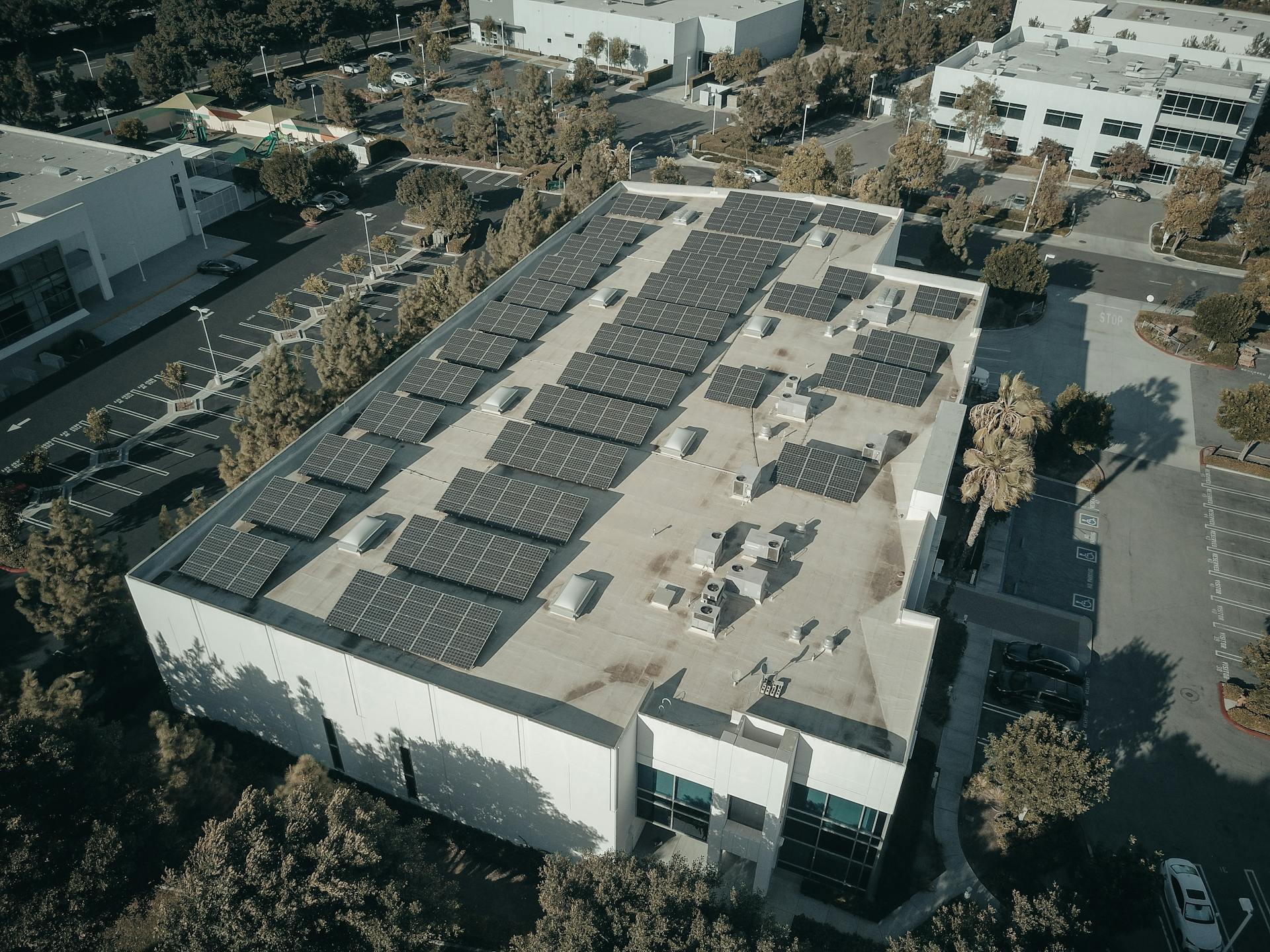
Commercial loans can be a vital source of funding for businesses, but with so many options available, it can be overwhelming to choose the right one. There are several types of commercial loans, each with its own unique characteristics and benefits.
One of the most common types of commercial loans is a term loan, which provides a lump sum of money that is repaid over a set period of time, typically 5-10 years.
A line of credit, on the other hand, allows businesses to borrow and repay funds as needed, often with a variable interest rate. This type of loan is ideal for businesses with fluctuating cash flow.
Businesses can also consider a commercial mortgage loan, which is used to purchase or refinance commercial property. These loans often have longer repayment periods, up to 25 years.
Understanding Commercial Loans
A commercial loan is a form of credit extended to support business activity. Most commercial loans are secured by collateral, and traditional financial institutions typically offer them to business entities like corporations and partnerships.
Commercial loans are debt-based financing used to fund business expenses, such as purchasing equipment or real estate. These loans are often available in larger amounts and require physical collateral.
Here are some key characteristics of commercial loans:
- Revolving/operating credit or reducing term debt with scheduled repayment intervals
- Secured by collateral, such as assets or property
- Maximum loan-to-value (LTV) ratio
- Amortization period based on the purpose of the loan
- Interest rate to compensate for the borrower's default risk
What Is?
A commercial loan is a form of credit that's extended to support business activity, often used to fund expenses like purchasing equipment or real estate.
Most commercial loans are extended to business entities like corporations and partnerships, with a few exceptions, such as commercial property owned by an individual.
Commercial loans are typically available in larger amounts and often require physical collateral, which can be a significant asset, like property, plant, and equipment.
Businesses can borrow from a commercial bank or credit union, or seek credit from equipment finance firms or private lenders like factoring companies.
Commercial loans are debt-based financing, meaning you borrow capital from a financial institution and repay it over time, with a focus on larger businesses and more in-depth applications.
You might like: Extended Payment Terms
Understanding Structure
Commercial loan structure is a crucial aspect of understanding commercial loans. Most lenders don't extend credit without a specific purpose, which is what bankers refer to as loan structure.
Lenders need to ask themselves a series of questions to structure a commercial loan. These questions include whether the financing will be revolving or reducing term debt, and what assets will serve as collateral.
Most commercial loans are secured by collateral, and lenders have predetermined credit policies that guide their decision-making. These policies help lenders determine the loan-to-value ratio and interest rate.
A lender's credit policies will also influence the amortization period, which is the length of time it takes to repay the loan. This period is based on the purpose of the commercial loan.
Here are some key factors lenders consider when structuring a commercial loan:
- Revolving or reducing term debt
- Collateral (assets used to secure the loan)
- Loan-to-value ratio (maximum amount borrowed against the asset)
- Amortization period (length of time to repay the loan)
- Interest rate (based on default risk)
Fundamentals of Credit
Commercial loans are often structured with a specific purpose in mind, such as financing a business or property. Most lenders don't extend credit without some form of collateral, which can be an asset that serves as security for the loan.
Commercial loan structure typically involves answering a set of questions, including whether the financing will be revolving or reducing term debt, and what assets will serve as collateral. This helps lenders determine the loan-to-value ratio and amortization period.
Lenders use credit policies to guide their decision-making, and most commercial loans are secured by collateral. This means that the lender has a tangible asset to fall back on if the borrower defaults.
The interest rate on a commercial loan is often determined by the borrower's projected default risk. This is why lenders evaluate factors like credit history and cash flow when making a loan approval decision.
Here's a breakdown of the key factors lenders consider when evaluating a commercial loan:
Meeting commercial real estate lending guidelines can secure favorable terms, especially for high-value properties. This typically requires a strong financial profile and business history.
How It Works?
Commercial loans are typically offered by banks, credit unions, and other financial institutions. They provide funds to businesses for various purposes such as expansion, equipment purchases, or debt consolidation.
The loan amount, interest rate, and repayment terms are usually determined by the lender's creditworthiness and business plan. This is because lenders consider the business's ability to repay the loan.
A commercial loan can be secured or unsecured. Secured loans require collateral, such as property or equipment, to guarantee repayment. Unsecured loans rely on the business's credit history and financials.
The loan term can vary from a few months to several years, depending on the agreement between the lender and borrower. This allows businesses to choose a repayment schedule that fits their cash flow.
Commercial loans often have higher interest rates compared to personal loans due to the increased risk for the lender. This is because businesses are more likely to default on loans than individuals.
The lender will typically require regular payments, including interest and principal, to be made on a set schedule. This can be weekly, biweekly, or monthly, depending on the agreement.
Check this out: Cash Advance Direct Lenders
Risk and Return
Commercial loans come in different types, each with its own risk profile. High-risk loans like hard money loans require higher interest rates.
Balancing project risk and potential returns is crucial for loan selection. This guides your strategic planning, especially for urgent needs.
Higher interest rates on high-risk loans are a trade-off for taking on more risk. This is a key consideration when choosing between different loan options.
SBA loans offer a lower-risk alternative, but may have more stringent requirements. They can be a good option for businesses with a solid financial history.
Readers also liked: Concentration Risk Definition
Types of Commercial Loans
Commercial loans come in many forms, each with its own unique characteristics. A commercial loan is most often thought of as a short-term source of funds for a business. Short-duration loans for commercial real estate are called mini-perm, usually having a three- to five-year term.
Some types of commercial loans are meant for specific purposes, such as equipment financing, commercial real estate loans, commercial auto loans, and commercial construction loans. These loans can help you purchase large or highly specialized equipment, buy or renovate property, buy vans, trucks or other vehicles for your business, and finance new building projects or major renovations.
See what others are reading: Amortising Term Loan
There are also more specialized types of commercial loans, such as SBA 504 Loans, which support major fixed asset purchases, including real estate or equipment, offering fixed commercial real estate loan rates with terms of up to 25 years. Hard money loans, on the other hand, focus heavily on the value of your collateral when underwriting applications.
Types of
Types of commercial loans can be overwhelming, but understanding the basics can help you navigate the process. A commercial loan is credit earmarked for a specific business purpose or expenditure.
There are various types of commercial loans, including equipment financing, which can help you purchase large or highly specialized equipment for your business. Commercial real estate loans can help you buy or renovate property, while commercial auto loans are used to buy vans, trucks, or other vehicles for your business.
Commercial construction loans finance new building projects or major renovations, and commercial bridge loans provide short-term financing typically used in commercial real estate to take advantage of an immediate opportunity and cover the gap until you can find a long-term loan option. Hard money loans are provided by private lenders and offer fast funding secured by property rather than credit.
Here are some common types of commercial loans:
- Equipment financing
- Commercial real estate loans
- Commercial auto loans
- Commercial construction loans
- Commercial bridge loans
- Hard money loans
Each loan type serves a specific purpose, tailored to different business needs and financial situations. For example, SBA loans are used by small businesses to finance commercial real estate, while hard money loans are used in high-risk situations or for quick-turnaround projects.
A commercial loan is often secured, meaning it's backed by physical collateral, and requires financial statements to prove the business's ability to repay. Many commercial loans require a down payment, with SBA loans requiring 10% and traditional mortgages requiring 20-30%.
It's essential to consider the key factors when choosing a loan, such as the loan term, interest rate, and repayment schedule. A blanket loan, for example, finances more than one property at the same time and can simplify the financing process for investors with multiple properties.
Additional reading: Example of Seller Financing for a Business in California
Traditional Bank
Traditional Bank loans are a common source of commercial real estate debt. They can be highly customizable based on the deal and borrower's profile.
Conventional financing, also known as traditional bank loans, can be obtained at both small, local banks and larger, national banks. Smaller banks tend to be more local in their decision-making and may be willing to make larger loans based on their understanding of the local market.
Local banks have smaller overall balance sheets, so loan sizes may be capped, but for the right deals, they may be willing to be more aggressive in their pricing and terms. They often prioritize building relationships with borrowers and may expect the sponsor to have significant equity in the deal.
In contrast, larger national banks have more rigorous underwriting criteria, making their rates and terms less flexible. However, they can provide larger loan amounts for established businesses with stable finances and solid credit.
Borrowers working with traditional banks should expect to have an active lending partner that closely monitors each deal to ensure all loan obligations are met. This is because traditional banks are heavily regulated.
Here's a brief comparison of local and national banks:
Traditional banks are often considered relationship lenders, meaning they want to know the borrower and the team behind the deal. They typically expect the sponsor to have 30-40% equity in the deal, although this can vary depending on the lender.
Agency
Agency loans are initiated by government-sponsored enterprises like Fannie Mae and Freddie Mac. They're designed to ensure Americans have access to affordable housing.
These loans can only be used for multifamily properties and typically require the property to be already stabilized. Borrowers who qualify often find agency loans to be the most competitive CRE financing option.
Agency loans are structured as non-recourse loans, meaning the borrower isn't personally responsible for repaying the loan if the property can't cover it. They're also made available at long-term, low-cost fixed rates.
Many agency loans include an attractive interest-only period, but this comes at a cost: flexibility. Borrowers can't easily modify their loan or prepay without penalty.
To obtain an agency loan, a borrower needs to contact a loan originator approved to underwrite loans to agency guidelines. Lenders like Walker & Dunlop, Berkadia, and CBRE are examples of national lenders that offer agency loans.
Check this out: How Much Is a Safe Deposit Box
Construction
Construction loans are perfect for funding new building projects or significant renovations. They allow for interest-only payments during construction, which gives developers flexibility in managing their cash flow.
Developers value these project-focused loans, but they come with higher interest rates. This means developers need to carefully consider their budget and financial situation before applying.
Construction loans require strict commercial real estate lending guidelines compliance. This means developers need to have a detailed budget and clear timeline in place for approval.
Here's an interesting read: Types of Loans That Dont Need a down Payment
Mezzanine
Mezzanine loans are a type of financing that combines debt and equity, offering extra capital without requiring full ownership transfer.
This option is particularly suitable for high-value investments where owners want additional funding without diluting their ownership.
Mezzanine loans work well in urban markets, providing businesses with flexible funding for profitable projects while maintaining control over their assets.
They often come with higher interest rates, but no collateral is required, making them an attractive choice for businesses looking for extra funding without giving up control.
Related reading: Crowd Funding for Business Startup
Traditional Mortgage
A traditional commercial mortgage is a great option for businesses with stable finances and solid credit, allowing them to accommodate larger loan amounts and balance flexibility with manageable monthly payments.
These loans offer extended commercial real estate loan terms of up to 20 years, with either fixed or variable interest rates, providing predictable payments.
Businesses can choose between fixed and variable interest rates, which can help them manage their finances effectively.
Traditional commercial mortgages are ideal for established businesses that can demonstrate stable finances and a solid credit history.
Down payment requirements for traditional mortgages can be as high as 20-30%, so it's essential for businesses to budget accordingly using a commercial loan calculator.
With a traditional commercial mortgage, businesses can focus on their operations and growth, knowing that their loan payments are predictable and manageable.
Mortgage-Backed Securities
CMBS loans are a type of commercial mortgage-backed security that pool loans into securities sold to investors. These loans offer lower interest rates and structured terms for stabilized assets like shopping centers or apartment complexes.
CMBS loans favor income-generating properties, providing commercial real estate loan terms ideal for long-term investments. They deliver stability, though they may limit flexibility on prepayments, fitting properties with predictable revenue streams.
A fresh viewpoint: Commercial Loans for Rental Properties
CMBS loans are often used for long-term loans on properties with existing, stable cash flows. They tend not to be flexible, and borrowers don't have many options to modify the loan to better meet their needs.
CMBS loans are generally considered a fallback option for borrowers who don't obtain financing through a traditional lender, agency lender, or life insurance company. The underwriting criteria for CMBS loans is less rigorous than these other alternatives.
Here are the key characteristics of CMBS loans:
- Pool loans into securities sold to investors
- Offer lower interest rates and structured terms
- Favor income-generating properties
- Deliver stability, but limit flexibility on prepayments
Interest Rates
Interest rates can be fixed or variable, affecting payment consistency. This means you'll know exactly how much you owe each month with a fixed rate, but with a variable rate, your payments can change over time.
Longer loan terms are designed to lower monthly payments, but they increase the total cost of the loan. This can be a good option if you need to keep your cash flow steady, but be aware that you'll pay more in interest over the life of the loan.
Evaluating commercial real estate loan rates is crucial to ensure the loan structure aligns with your budget. This involves considering your income, expenses, and financial goals to determine the best loan terms for your business.
Sources
- https://corporatefinanceinstitute.com/resources/commercial-lending/commercial-loan/
- https://www.alliancecgc.com/education/the-different-types-of-commercial-real-estate-loans
- https://www.rok.biz/blog/understanding-the-different-types-of-commercial-real-estate-loans/
- https://www.investopedia.com/terms/c/commercial-loan.asp
- https://www.nerdwallet.com/article/small-business/commercial-business-loans
Featured Images: pexels.com


